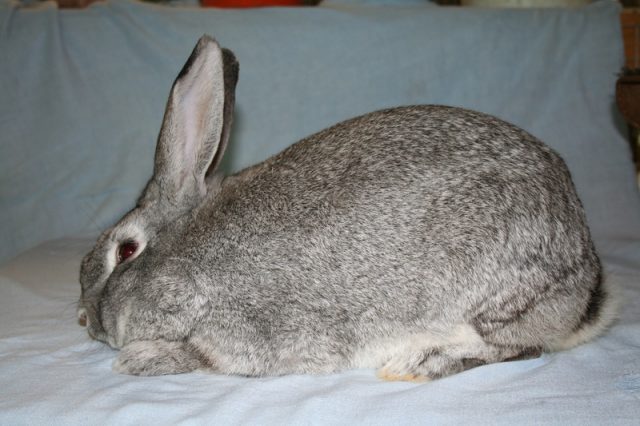Type the name of the breed you're looking for below
[wpdreams_ajaxsearchlite] Don't see the breed your're looking for? Click here and let us know!
Breed Characteristics
1 paw - breed exhibits the least amount of this characteristic
5 paws - breed exhibits most amount of this characteristic
Giant Chinchilla rabbit
| Origin | The Giant chinchilla has the highest minimum senior weight at 13 pounds, but it is not actually the largest breed. While the Checkered Giant, Flemish Giant, and French Lop have no cap on senior weights, Giant Chinchilla bucks must not be over 15 pounds and does must not be over 16. There are three breeds of chinchilla rabbits, but the Giant, no surprise, is the largest. It’s also the most recently developed, but that’s not saying much because all three breeds sprung up about the same time, when the chinchilla rabbit took the US by storm in the 1920’s and 30’s. The Chinchilla rabbit arrived in America in 1919. Immediately breeders saw the potential for big profits through the fur market. However, the original chinchilla rabbit, the Standard, weighed only 5-7 pounds. Breeders began work on a 9-11 pound version that became the American Chinchilla, but a Mr. Edward H. Stahl had even bigger ideas. He took a Standard Chin buck to New Zealand white does, and from there introduced American Blues and white Flemish Giants. Through many parings and careful selection, he produced the breed we now know as Giant Chinchilla. His first doe that he felt was ideal was named “Million Dollar Princess,” and became the poster child for the breed. “The Princess” was born in 1921, but it wasn’t until 1928 that Stahl could get a working standard for the breed from the ARBA of the time. Today the Giant Chin is called the “Million Dollar Rabbit.” Interestingly, Mr. Stahl DID make a million dollars selling rabbits, the only person to achieve such a height before or since. He had large operations in Missouri and New York to produce chinchillas that he shipped all over the country. Today one of the most famous names in Giant Chins is Judge Mr. Carl Fillater. However in his presentation at the ARBA national judge’s conference in 2010, he made the remark: “It is also known as the Million Dollar Rabbit. I have yet to make my first free and clear dollar off of them in the forty plus years I have been raising them!” There’s certainly not as much money in raising rabbits these days! The Giant Chinchilla is in the semi-arch group, but really it has a different body type than other breeds in that category such as the Flemish or Beveren. The standard calls for a medium-length body, not one that’s as long as possible. It also is the only chinchilla breed with a flyback coat. It is to be judged primarily for meat-producing qualities, and can grow a fast fryer up to seven pounds in just eight weeks. The Giant Chinchilla is a result of crosses between Chinchilla and Flemish Giant breeds; it originates in the United States. This breed is used primarily as a commercial meat rabbit. |
Physical Attributes
| Weight | 12 lbs. (5.4 kg) MINIMUM |
| Ear Type | Erect |
| Fur Type | Flyback |
| Colours | Fur is banded slate-blue, pearl, and black. |
| Appearance | Fur is banded slate-blue, pearl, and black. |
| Other Considerations | Life Expectancy: 5-8 years Temperament: Gentle |
| Best Kept In | Pen. Cage or Yard. |



